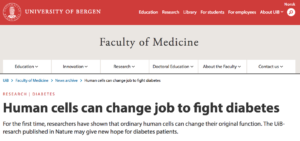Cell-identity switches, in which terminally differentiated cells are converted into different cell types when stressed, represent a widespread regenerative strategy in animals, yet they are poorly documented in mammals. In mice, some glucagon-producing pancreatic α-cells and somatostatin-producing δ-cells become insulin-expressing cells after the ablation of insulin-secreting β-cells, thus promoting diabetes recovery. Whether human islets also display this plasticity, especially in diabetic conditions, remains unknown. Here we show that islet non-β-cells, namely α-cells and pancreatic polypeptide (PPY)-producing γ-cells, obtained from deceased non-diabetic or diabetic human donors, can be lineage-traced and reprogrammed by the transcription factors PDX1 and MAFA to produce and secrete insulin in response to glucose. When transplanted into diabetic mice, converted human α-cells reverse diabetes and continue to produce insulin even after six months. Notably, insulin-producing α-cells maintain expression of α-cell markers, as seen by deep transcriptomic and proteomic characterization. These observations provide conceptual evidence and a molecular framework for a mechanistic understanding of in situ cell plasticity as a treatment for diabetes and other degenerative diseases.
Continue your reading here:
Diabetes relief in mice by glucose-sensing insulin-secreting human α-cells
Authors: Furuyama K, Chera S, van Gurp L, Oropeza D, Ghila L, Damond N, Vethe H, Paulo JA, Joosten AM, Berney T, Bosco D, Dorrell C, Grompe M, Ræder H, Roep BO, Thorel F, Herrera PL.
Journal: Nature (2019), PMID:30760930
DOI information: 10.1038/s41586-019-0942-8
Research highlighted in:


